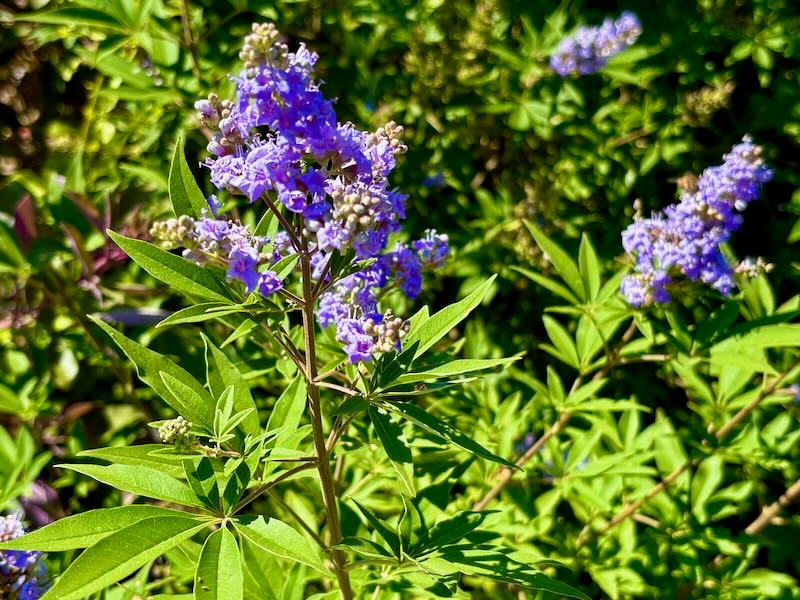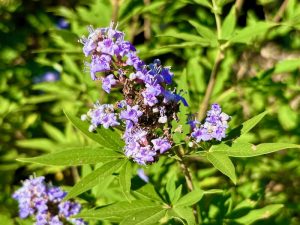Vitex agnus-castus: A Complete Guide to the Chaste Tree
Vitex agnus-castus, widely known as the Chaste Tree, Chasteberry, Chastetree, Texas Lilac, or Monk’s Pepper, is a striking deciduous shrub or small tree in the Mint family, Lamiaceae. Native to the Mediterranean, western Asia, and parts of northern Africa, this plant has gained global popularity for its long spikes of violet to lavender flowers, aromatic foliage, and reliable drought tolerance. With its graceful form and fragrant blooms, Vitex agnus-castus has become a staple in pollinator gardens, cottage landscapes, and warm climate yards.
The History and Names of Vitex agnus-castus
The Chaste Tree has carried a remarkable reputation for centuries. Its scientific name reflects a repetition of the word “chaste” in both Greek and Latin, pointing to its symbolic ties with purity. In Greek and Roman culture, the leaves and fruits were believed to encourage chastity, which explains the enduring common names such as Chasteberry and Monk’s Pepper. Monks in the Middle Ages reportedly chewed the pungent seeds to suppress desire, reinforcing the plant’s mystical associations.
The plant’s uses, however, went far beyond symbolism. The dried fruits and leaves flavored foods in Mediterranean kitchens and were ground into spice blends. In folk medicine, extracts were employed for reproductive and hormonal health, and today herbal supplements featuring Chasteberry remain popular. Ancient festivals such as the Greek Thesmophoria honored Demeter and Persephone with branches of Vitex, and archaeological evidence even reveals its presence in sacred spaces. This long cultural history adds depth to the plant’s modern appeal in the garden.
Appearance of the Chaste Tree
Vitex agnus-castus is instantly recognizable for its airy, hand-shaped foliage and flower spikes. The leaves are palmately compound, made up of five to seven narrow, lance-shaped leaflets. The gray-green upper surfaces contrast with silvery undersides, and when bruised, the leaves release a strong, pleasant aroma.
During summer, the shrub bursts into bloom with long, upright clusters of lavender to violet-blue flowers. White and pink forms also exist, and newer cultivars expand the color palette even further. These blooms are rich in nectar, attracting pollinators in abundance. After flowering, small purple drupes develop, historically harvested as spice and medicine.
The plant grows between 3 to 5 meters (10 to 16 feet) tall, though in warmer climates it can stretch to 6 meters (20 feet). Depending on how you prune, it may take the form of a large, multi-stemmed shrub or a single-trunk ornamental tree with an open, rounded canopy. Its spreading habit and fragrant flowers make it a visual anchor in any garden.
Flowering Season of Vitex agnus-castus
The Chaste Tree produces an extended floral display that begins in late spring or early summer and continues through early autumn. In climates with long summers, pruning spent spikes can trigger a second flush of blooms. Flower intensity depends on sunlight and soil fertility, but under good care, gardeners enjoy months of steady color. In USDA Zones 7–9, the blooming season is especially long, while in cooler zones it may start later and end earlier.
Growth Habit and Environmental Tolerance
This is a fast-growing plant, often adding up to 60 cm (2 feet) in height each year when young. Its natural form is upright but spreading, with a soft, open canopy. Once established, Vitex agnus-castus tolerates drought, poor soils, and even urban pollution. It thrives in USDA Zones 6 to 9, and in colder zones, the top growth may die back to the ground in winter. However, since the flowers appear on new wood, vigorous spring regrowth will still deliver blossoms.
The plant also tolerates heat, moderate salt, and dry soils, making it a useful choice for coastal and Mediterranean-style landscapes. In frost-free regions, it can remain semi-evergreen. Its adaptability and toughness make it a reliable performer across a wide range of climates.
How to Grow Vitex agnus-castus
Light
Plant the Chaste Tree in full sun for best results. Six to eight hours of direct sunlight each day ensures dense flowering and compact growth. While it can survive in partial shade, blooms are reduced.
Soil
This shrub thrives in well-draining soils ranging from sandy to loamy textures. It adapts to slightly acidic through alkaline conditions but struggles in heavy clay or waterlogged soils. Adding compost at planting boosts fertility and balances moisture.
Watering
During the first growing season, water once a week to establish a deep root system. Once established, the plant becomes highly drought-tolerant and requires only occasional watering. In dry spells, a deep soak every two to three weeks supports flowering. Always let the top few inches of soil dry between waterings to avoid root rot.
Fertilizing
Apply a balanced fertilizer in spring to support healthy foliage and blooms. After the first flush of flowers, switch to a high-potassium fertilizer to encourage reblooming. Avoid high-nitrogen fertilizers, which promote leafy growth at the expense of flowers.
Pruning
Prune in late winter or early spring before new growth emerges. Remove dead or crossing branches and shape the canopy. Because blooms form on new wood, pruning never reduces flowering. Light pruning of spent spikes after summer flowering encourages a second round of blooms. If shaping as a tree, remove lower branches over time.
Propagation of Vitex agnus-castus
Propagation can be done from seed or cuttings.
- Seed propagation requires fresh seed, as viability declines quickly. Sow seeds in late winter or early spring in a warm, protected environment. Germination may be slow and erratic.
- Cuttings are the most reliable method. Semi-hardwood cuttings taken in midsummer root well under mist or in a humidity dome. Hardwood cuttings can also root if taken in late autumn and placed in a cold frame. Each cutting should be 8–10 cm (3–4 inches) long with at least two nodes.
Division is not practical since the plant grows from a woody base.
Cultivars of Vitex agnus-castus
Many named cultivars highlight the diversity within this species.
- ‘Blue Diddley’: A compact dwarf variety, reaching only 90–120 cm (3–4 feet), ideal for small gardens and containers.
- ‘Blue Puffball’: Another dwarf form, rounded and neat, with deep violet flowers.
- ‘Cooke’s Blue’, ‘Cooke’s Pink’, and ‘Cooke’s Purple’: Larger cultivars that can reach 7–9 meters (25–30 feet) with abundant flower spikes in different shades.
- ‘Shoal Creek’: A vigorous cultivar with long, rich blue flower spikes, favored for landscapes needing larger specimens.
These options allow gardeners to enjoy the beauty of Vitex in settings from small borders to expansive landscapes.
Landscape Uses for Vitex agnus-castus
The Chaste Tree shines as a versatile garden plant. It works well as:
- A specimen tree, standing alone as a focal point.
- A multi-stemmed shrub in pollinator or cottage gardens.
- A flowering hedge or privacy screen.
- A drought-tolerant feature in Mediterranean or xeriscape landscapes.
- A container-grown ornamental in smaller yards.
Its graceful foliage and long blooming season also make it valuable in wildlife gardens, where it supports bees, butterflies, and even birds that consume its small fruits.
Traditional and Modern Uses
Beyond its ornamental role, Vitex agnus-castus carries centuries of cultural significance. Ancient Greeks used branches in fertility and harvest festivals, while Romans associated it with purity and chastity. Medieval monks gave rise to the name Monk’s Pepper by using the pungent seeds as a spice substitute.
Modern herbal medicine still employs Chasteberry supplements, mainly for women’s reproductive health. Scientific evidence remains limited, but extracts are popular worldwide. Essential oils from the fruits and leaves are also being studied for antibacterial and anti-inflammatory properties.
Pollinators and Wildlife
Chaste Tree is a magnet for pollinators. Bees, butterflies, and hummingbirds visit its nectar-rich spikes all summer long. Birds also feed on the small purple drupes in autumn. Deer usually avoid it, thanks to its aromatic foliage, while its drought tolerance and resistance to urban pollution make it a sustainable landscape choice.
Pests and Diseases
Vitex agnus-castus is generally resistant to pests and diseases. However, thrips can occasionally damage flowers, and root rot may occur in poorly drained soils. In humid climates, leaf spot or mildew may appear, though they rarely cause serious harm. Regular pruning for air circulation and proper watering practices keep most issues at bay.
Quick Troubleshooting Guide
- Few flowers: Not enough sunlight or too much nitrogen fertilizer.
- Yellowing leaves: Overwatering or poor drainage.
- Wilting despite watering: Root rot, check soil conditions.
- Dieback in winter: Normal in colder zones; prune back in spring.
- Spreading too fast: Remove unwanted seedlings and thin growth.
Conclusion
Vitex agnus-castus, the Chaste Tree, combines history, fragrance, resilience, and ornamental beauty in one package. With lavender-blue flower spikes, aromatic foliage, and outstanding drought tolerance, it enriches gardens from the Mediterranean to suburban landscapes worldwide. Whether grown as a small ornamental tree, a flowering hedge, or a pollinator magnet, it rewards gardeners with months of color and centuries of cultural stories.
By planting it in full sun, providing well-drained soil, and pruning at the right time, you can enjoy years of reliable performance. Add to this its traditional symbolism, medicinal uses, and modern cultivars, and it’s no wonder Vitex agnus-castus continues to earn a cherished place in gardens today.



